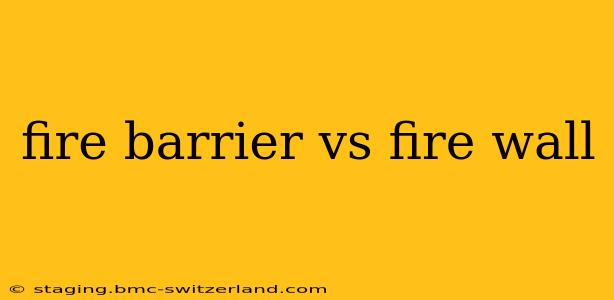The terms "fire barrier" and "firewall" are often used interchangeably, leading to confusion. However, these terms represent distinct building components with different purposes and functionalities in fire safety. This article will clarify the key differences between fire barriers and firewalls, helping you understand their roles in protecting buildings and occupants from fire spread.
What is a Fire Barrier?
A fire barrier is a continuous, fire-resistant vertical or horizontal assembly that restricts the spread of fire and smoke within a building. It's designed to compartmentalize a structure, limiting the extent of fire damage and providing time for evacuation. Fire barriers are crucial for preventing the rapid spread of fire between different sections of a building, thereby improving life safety. Think of them as dividing walls that offer significant fire protection. They are tested and rated according to their ability to withstand fire exposure for a specified period, usually measured in hours. This rating is a crucial factor in determining their effectiveness.
What is a Firewall?
A firewall, while also contributing to fire safety, differs significantly from a fire barrier in its primary purpose and application. Firewalls are external fire-resistant walls that separate buildings or portions of buildings to prevent the spread of fire from one structure to another. They act as a complete physical separation, designed to withstand intense fire exposure for an extended period. Unlike fire barriers that primarily focus on compartmentalizing a single building, firewalls are more concerned with preventing the spread of fire between separate structures or across property lines.
Key Differences Between Fire Barriers and Firewalls: A Comparison
| Feature | Fire Barrier | Firewall |
|---|---|---|
| Purpose | Compartmentalize a single building | Separate buildings or building sections |
| Location | Within a building (vertical or horizontal) | Between buildings or building sections |
| Function | Restricts fire and smoke spread within a building | Prevents fire spread between buildings |
| Construction | Varies depending on fire rating requirements | Typically robust construction with high fire resistance |
| Rating | Measured in hours of fire resistance | Measured in hours of fire resistance; often higher ratings than fire barriers |
What are the different types of fire barriers?
Fire barriers aren't a single monolithic entity; their design varies according to the specific application and required fire resistance rating. Common materials used in constructing fire barriers include:
- Fire-rated drywall: A common and cost-effective solution.
- Concrete: Offers superior fire resistance.
- Steel: Often used in conjunction with fireproofing materials.
- Specialized fire-rated assemblies: This category includes numerous proprietary systems designed to meet particular fire protection requirements.
The selection of materials and the construction method are critical to achieving the necessary fire rating.
What are the materials used in constructing firewalls?
Similar to fire barriers, firewalls employ a range of materials selected to achieve the required fire resistance rating. However, due to the greater potential fire exposure, firewalls typically utilize more robust and higher-rated materials, such as:
- Reinforced concrete: Offers exceptional durability and fire resistance.
- Masonry construction (brick or block): Provides excellent fire protection and structural integrity.
- Specialized fire-rated assemblies: These include advanced systems specifically designed for exterior firewall applications.
Are there specific building codes and regulations for fire barriers and firewalls?
Yes, both fire barriers and firewalls are subject to stringent building codes and regulations. These regulations vary depending on the location and the specific type of construction. Consult your local building codes and relevant fire safety standards for precise requirements.
Conclusion
While both fire barriers and firewalls play vital roles in fire safety, understanding their distinct functions is crucial for designing and constructing safe buildings. Fire barriers compartmentalize within a building, while firewalls separate different structures. Always adhere to local building codes and consult with fire safety professionals for guidance on choosing and implementing appropriate fire protection measures.
